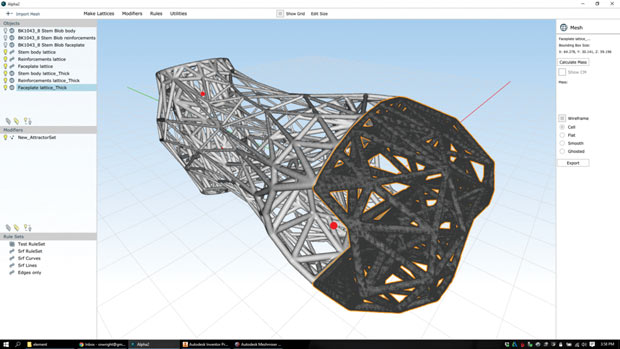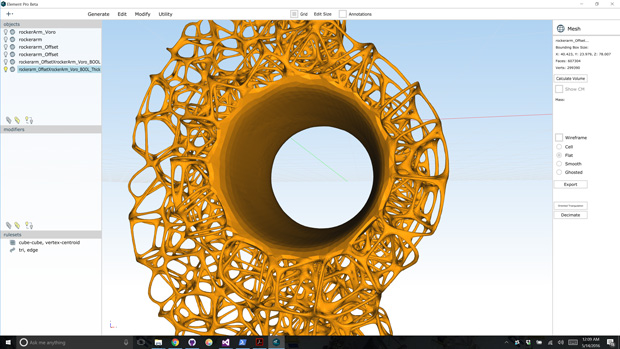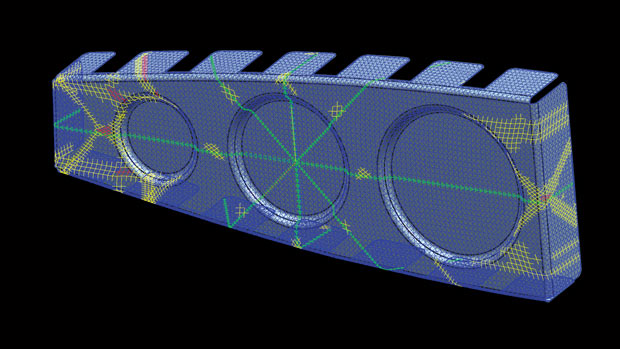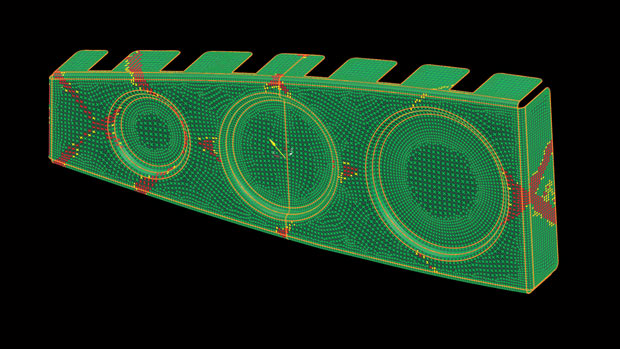The Symbiotic Relationship Between Materials and Manufacturing

Founded in early 2014, Frustum describes its software Generate as an “optimization that brings design and topology optimization together as one.” Image courtesy of Frustum.
Latest News
July 1, 2016
There’s no such thing as damage-proof design. It’s a reality that most manufacturers have to accept. Patrick Morelle, Siemens PLM Software’s senior marketing manager for composite products, revealed the aerospace manufacturers’ strategy. “Their approach is to come up with damage-tolerant design,” he says. “It means the design allows the damage to occur in a controlled way.”
One way to control damage is to predict where, when and how it would propagate. When working with standard materials (metal or plastic), engineers rely on structural analysis, computational fluid dynamics (CFD), and finite element analysis (FEA) software packages to simulate and predict a wide range of failure scenarios. But composites—made by combining two or more materials as fiber strands and plies—demand a more sophisticated form of simulation.
Damage simulation is just one aspect of composite design. Some industry experts and insiders have come to realize that, with composite products, the material-making process and the manufacturing process are inseparably linked to the product’s performance.
“With composites, the manufacturing process itself is a constraint on the design. If you don’t consider it, you may quickly arrive at a design that cannot be manufactured,” says Morelle. “CAE technologies have integrated models to assess damage growth in composite airplane components and fuselage. Today, they constitute the designer’s guideline, not only to replace expensive real physical testing, but also to answer what-if questions very early in the design cycle.”
 nTopology plans to deliver an optimization software to help engineers make better 3D-printed parts. Image courtesy of nTopology.
nTopology plans to deliver an optimization software to help engineers make better 3D-printed parts. Image courtesy of nTopology.Composition Studies
The fact that composites are made or designed is both a blessing and a curse. Because they’re produced with fiber strands and plies, engineers can experiment with different configurations in fiber direction and ply stacking order to arrive at the desired stiffness, flexibility and durability.
But it also means the process of material making has to be examined, analyzed and perfected. Siemens PLM Software markets its Fibersim software solutions to engineers working with composites. It’s developed to integrate with three industry-standard CAD packages: Siemens PLM Software’s NX, Dassault Systèmes’ CATIA and PTC’s Creo.
“Because it’s CAD-based, Fibersim brings together the key aspects of composite product development—part shape, material form and manufacturing process—that provide awareness of the material behavior and fiber orientations,” says Leigh Hudson, director of Product and Market Strategy for Fibersim at Siemens PLM Software. “The ability to share the resulting definition and behavior between structural, design and manufacturing engineers ensures the performance optimization of composite parts.”
Dassault Systèmes, known for its 3DEXPERIENCE platform, believes its BIOVIA product line provides a critical capability to address composites design and its relation to underlying molecular/atomic structure. BIOVIA is focused on the scientific determination of materials, properties, characteristics and behavior. “The first priority is to understand the materials and how they behave. We address that with the combination of capabilities in design and simulation capabilities within the CATIA, BIOVIA and SIMULIA brands,” says Rani Richardson, CATIA business consultant at Dassault Systèmes.
Last April, engineering software maker Altair acquired Multiscale Design System (MDS). In the announcement, Altair called the acquisition a move to bring “tighter solver integration for composite material modeling, fatigue and multiphysics.” Uwe Schramm, Altair’s CTO, says: “We will continue to develop, enhance and invest in MDS as part of HyperWorks while retaining an open architecture approach with respect to other third-party solvers. Altair is committed to creating good interfaces and continuing to build partnerships to excel in the domain of composite materials.”
Among MDS’ products are MDS-OP for parametric optimization of woven fiber architecture and MDS-FT, for simulating damage initiation and propagation in fiber structures. “MDS allows you to model composites at the fiber matrix level. It lets you see what’s happening at the micro-mechanical level. It’s a good way to look at fatigue initiation, crack propagation and fiber breakage,” says Robert Yancey, vice president of Additive Manufacturing at Altair.
Computer-Assisted Design Exploration
Whereas engineers once decided on the shape of the products based on domain expertise and aesthetic preferences, they now increasingly turn to software that can mathematically compute and recommend the best (or optimal) geometry. With traditional materials, computer-assisted optimization is an option; with composites, it may be compulsory. “You have so many degrees of freedom with composites that you can quickly get lost if you don’t get some guidance from optimization algorithms,” says Morelle.
 Composite airplane rib showing material behavior and fiber orientations resulting from the manufacturing process using Fibersim. Image courtesy of Siemens PLM Software.
Composite airplane rib showing material behavior and fiber orientations resulting from the manufacturing process using Fibersim. Image courtesy of Siemens PLM Software.But robust, time-tested algorithms for optimizing composites are not easy to come by. “Design variables are so different in composites than they are in metals,” explains Morelle. “You can easily adopt the present optimization methods to anisotropic composite materials, but you have new constraints to satisfy, like the composite stacking sequence. Some of the rules are difficult to implement in an automatic optimization algorithms, but will have to be taken into account in future optimization strategies.”
Reflecting on his own early experience as a budding designer, Jesse Blankenship, CEO of Frustum, says: “Optimization tools were very prevalent but not helpful, because they targeted the needs of stress analysts. Designers were very interested in them but had a hard time making use of them. You had to be very determined.”
That’s why he founded and launched Frustum in the beginning of 2014 to offer an integrated optimization platform for designers. The software Generate is described as an “optimization platform that brings design and topology optimization together as one.”
“If you’re going to optimize a large structure to be made in composites, you don’t necessarily need a different set of algorithms,” Blankenship notes. “But you will likely need a different set of objectives, constraints and material considerations. Setting up an optimization for a composite part, for example, will be fairly different from setting it up for the same design in metal.”
 Composite airplane rib showing fiber orientations in FEM that were provided by Fibersim for increased accuracy during structural analysis. Image courtesy of Siemens PLM Software.
Composite airplane rib showing fiber orientations in FEM that were provided by Fibersim for increased accuracy during structural analysis. Image courtesy of Siemens PLM Software.Constructed out of woven fibers and plies, composites do not stretch, break or bend the same way in all directions as metals do. The fiber direction and the ply stacking order affect the performance of the finished composite products. Existing optimization methods use stress and strain calculation—the foundation in FEA—to determine where the design needs reinforcement, and where materials can safely be removed. Incorporating additional factors—like ply stacks and fiber directions—to account for their effects on composite products’ performance is a daunting software development challenge.
Layered Complexity
The combination of additive manufacturing (AM) and composites offers some manufacturers a way to reduce assembly complexity by replacing hundreds or thousands of discrete assembly components with a single large frame or structure. But applying large-scale industrial AM to composites invites new challenges not found in the more modest 3D printing projects.
“Composites manufacturing itself is additive with some subtractive machining and, from a traditional continuous fiber standpoint, is performed with automated fiber placement and tape laying. Fibersim provides the ability to design for these traditional AM processes through knowledge of the machine parameters that affect the design and material behavior,” explains Siemens PLM Software’s Hudson.
Altair’s Yancey adds: “The automated tape-laying machines lay down strips of composite material. Then you cut the strips so you can get straight edges or stair steps at the end of the plies. But sometimes there’s a difference between what the designer turns in and what manufacturing can actually make. Some corners cannot be made with machines; some curvatures might cause problems; sometimes you cannot get the angle you designed in the ply.”
 Founded in early 2014, Frustum describes its software Generate as an “optimization that brings design and topology optimization together as one.”
Founded in early 2014, Frustum describes its software Generate as an “optimization that brings design and topology optimization together as one.”Image courtesy of Frustum.
Simulating composite construction usually involves simulating the effects of draping composite laminates on curved surfaces. “Our software gives you a way to simulate the forming operation, to see what the angles would be like across the surface,” says Yancey. “There are sophisticated software packages that do this, but they tend to be fairly expensive. Our customers tell us they don’t need a solution that’s 100% accurate, but want something that gives them general guidance. So we included that feature in Altair’s HyperMesh.”
Dassault Systèmes’ Richardson identified three hurdles to industrial adoption of AM: “The first is understanding the materials and how they behave. We address that with BIOVIA. The second issue is functional generative design, the capability to create more organic optimized shapes with design for additive manufacturing. That’s topology optimization, the area for generative design [algorithm-driven design]. The last is manufacturing process control. It’s important to make sure the so-called optimal topology is manufacturable, and to build the support structures as needed for the manufacturing process.”
Dassault Systèmes is preparing to release a CATIA module, titled Generative Design Explorer (GDE). Richardson said the GDE is built on top of TOSCA, the company’s optimization software. By placing it inside CATIA, Dassault Systèmes is “putting topology optimization in the hands of designers,” she adds.
A Growing Appetite for Lattice
The advantage of lattice and honeycomb structures for lightweight design is beyond dispute. Their porous construction allows a volume to be filled with less material than solids. Their network of nodes and stems reinforce one another, resulting in tremendous sturdiness and resistance. CAD and simulation software makers are now in a race to develop tools that can facilitate such designs. It’s not practical to model lattice structures one beam at a time, one node at a time. Therefore, the preferred approach is to let the software fill a predefined geometric volume with microelements, using robust automation algorithms.
In 2014, Autodesk bought the London-based Within Labs, which specializes in generative design or algorithm-generated geometry. The acquisition gave the design software giant the foundation technology for Autodesk Within, released in July 2015. Several months prior to Autodesk Within’s debut, Altair announced it had added a solver to model, analyze and simulation lattice structures in its OptiStruct software.
Altair added lattice structures to its OptiStruct software last year. With OptiStruct’s topology optimization, areas between full density and open spaces can automatically be filled with lattices in an intelligent manner, providing weight-efficient structures that mimic structures seen in nature. “We have seen good interest in this technology in aerospace, medical and architecture markets, and have developed the necessary interfaces to go from lattice topology optimization results to additively manufactured parts,” Yancey comments.
About a year and a half ago, nTopology transitioned from a consultancy to a software company.
According to its site, its founders have but one goal: To help engineers make better 3D-printed parts. The company writes: “Our software offers a fluid transition from mechanical design to DFM (design for manufacturability), and allows for both explicit and computer assisted creation of highly complex lattices structures … With our unique combination of generative, manual and simulation-based design tools, we let engineers create parts whose functional requirements are baked right in. With Element, you can optimize lattice structures with respect to user-defined inputs, imported data or our integrated FEA, letting you make the right parts for your application, every single time.”
“Our free product, Element Free, is pure lattice design software—it doesn’t have any built-in simulation or optimization,” reveals Spencer Wright, vice president of Product at nTopology. “But in the coming months we’ll be both releasing our own FEA modules and integrating with commercially available packages, enabling Element to simulate your structure and then use those simulations to drive the design.”
Producing lattice structures with composites it not incomprehensible, but it would require new approaches. “Composites work better with tension than with compression, so you want to direct your forces along the fiber strands to make it work best for you. The difficulty is in adding variability [in lattice thickness, density or distribution]. Our software gives you an intelligent way to do that,” notes Wright.
Because generating and displaying complex lattice networks is compute-intensive, nTopology Element requires a healthy amount of RAM and a modern graphics card with up-to-date drivers. The company tests its software with both AMD and NVIDIA’s professional hardware.
A lot of the times, the output—the software-proposed optimal shape—requires additional work, because it’s seldom in a manufacturing-ready state. Mathematically optimal shapes, as it turns out, are invariably too rugged, unorthodox and asymmetrical to be produced in traditional machines and cutting tools. Frustum’s Blankenship believes he can change that. “We are focused on giving you geometry output that can be manufactured. Instead of using the output from the optimization as the inspiration for your design, you can use the output from our software as the design,” he says.
Blankenship says Frustum Generate is targeting much more than structural analysis in its optimization calculations. “We are doing research into using other objective functions to inform the geometry—we’ll consider fluid dynamics, thermal stress, even resonance frequency. In the future, you’ll see more vendors focusing on producing manufacturable geometry, based on your input for preferred manufacturing method.”
That is the goal for Blankenship. Currently, the beta version outputs 3D printable geometry but is not sophisticated enough to produce optimized shapes that are also manufacturing-ready for all kinds of materials and methods. “But within a year, that’s what you’ll see coming from our software,” promises Blankenship.
Frustum Generate is available for both cloud-hosted and on-premise deployment. “One of the reasons we run our software in the cloud is to bring the high resolution to the designer, who otherwise would need to purchase a lot of hardware to bring the computing power required,” says Blankenship. “The ability to conduct analysis in higher resolution, with a higher number of finite elements, generally yields greater accuracy.
Materials and Manufacturing Methods
Frustum’s Blankenship anticipates additive manufacturing will play a bigger role in industrial operations in the near future, both in optimized direct parts and optimized manufacturing processes. “AM is no doubt a promising technology for mass production,” he says. “You can make an actual frame with it, or the mold needed to make the frame. Five years from now, we’ll see much more mass-production using 3D printing because the performance payoff is so great. In fact, we are already seeing some injection molding companies using AM as part of their process to eliminate costly steps.”
The prevalent sentiment in manufacturing is to encourage the design team and manufacturing team to work closely together. With composite design, this strategy is critical to the success of the project. “In aerospace, there is a very good understanding of how to design a composite part for an elected manufacturing process,” Siemens PLM Software’s Hudson says. “Automotive is still investigating design and manufacturing options for the use of composite within a high volume production environment. Realizing the true value of composites relies on an understanding of the material behavior in the context of the manufacturing process to overcome both structural and manufacturing challenges.”
More Info
Subscribe to our FREE magazine, FREE email newsletters or both!
Latest News
About the Author
Kenneth Wong is Digital Engineering’s resident blogger and senior editor. Email him at [email protected] or share your thoughts on this article at digitaleng.news/facebook.
Follow DE





